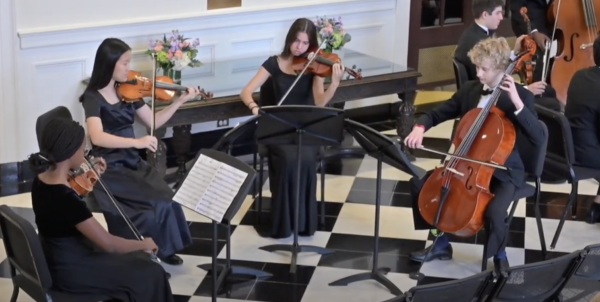Proof stands out with small cast size, fosters discussion
Within weeks of the closing of Titanic, the StageCats took on a new play: Proof. But this one charted a completely different route from Titanic’s massive spectacle. Proof is a simple show, set on a back porch with a premise of mathematical theory and a family torn apart. Directed by Maggie Bailey and student director and senior Tate Burwell, it featured a cast of only four people: seniors Alex Gist, Nicholas Tassopoulos, Molly Wright, and sophomore Ellie Panetta.
Proof debuted off-Broadway in 2000, written by American playwright David Auburn. It won the 2001 Pulitzer Prize for Drama and the 2001 Tony Award for Best Play. The play is set in modern day Chicago and tells the story of a mathematician named Robert, who has recently passed away from a mental illness, his daughters Catherine and Claire, as well as Hal, a student of Robert’s who becomes Catherine’s love interest after Robert’s passing.
Robert had serious mental health issues. Although the play never explicitly says the illness he suffers from, it is inferred that he had schizophrenia and dementia. He was always taken care of by Catherine; when Robert passes away, his older daughter Claire comes to Chicago from New York to deal with the funeral arrangements. Claire then tries to convince Catherine to move to New York with her. Catherine also deals with her fears of sharing her father’s mental issues due to their shared mathematical genius. Meanwhile, Catherine and Hal find mathematical discoveries in one of Robert’s journals, which Catherine claims were hers. Claire and Hal, however, struggle to believe her. The show is full of cunning dialogue, realistic family drama, and even romance.
Through Robert’s character, Proof brings to life a conversation about mental health – an important reason the school chose the play. With the help of student leaders Keller Harper, Benton Wood, and Wright, the school is seeking to further mental health initiatives by starting a chapter of Active Minds, an organization that works to fundraise and hold forums for discussions about mental health.
Proof differed majorly from the fall musical, Titanic, due to the cast size. Titanic’s cast featured 65 actors and actresses, the largest cast in Westminster history. Proof’s cast of only four contrasted largely with the other show.
“For Titanic, we knew it was going to be a titanic cast,” said director of theater arts Kate Morgens, who, along with other faculty involved with the theater department, chose both shows. “We needed another complementary play, which was a little bit smaller, because they were both going to be at the same time. So any students that were in Titanic were not going to be in Proof, and the students in Proof were not going to be in Titanic.”
While many students in Titanic had supporting or ensemble roles, every role in Proof was a lead role.
“It’s very different because for Titanic, some kids in the cast didn’t even know each other, and it was very unorganized and hard to get things done,” said Panetta. “But for us, it’s easier because it’s straightforward. There’s not a lot of us, so each of us has a lot of responsibility, and we can hold up our own responsibilities.”
Some were more apprehensive to work with such a small cast because of the amount of responsibility and pressure put on each actor to perform well.
“Everyone is held more accountable,” said Burwell, “because you really notice when someone’s not there, [or] when someone’s not prepared for the day.”
The actors believe, however, that the small cast size was a huge plus in terms of cast dynamic and one-on-one contact with the director.
“There are no disadvantages – only advantages to being in a small cast,” said Gist. “The advantages are…you’re on stage a lot longer, you get more attention from the director, and it’s also much easier to bond with your cast mates.”
Another contrast between Titanic and Proof was the content of the two plays. Titanic was a massive spectacle with a full ship onstage, realistic sound effects, choreographed dances, massive musical numbers, and costumes true to the era. Proof, on the other hand, had less tech elements because it is set on a back porch with minimal props or effects.
“I’ve seen Titanic. They had a huge pit orchestra, they had flashy costumes, [and] amazing lighting design,” said Burwell. “I thought it was fabulous, but it was a lot more of a spectacle, I would say.”
Meanwhile, Proof is a more simple show that asks the audience to focus more on its dialogue and overall message.
“Proof is more understated [compared to Titanic]. It all takes place on the back porch of a house, but I think the dialogue is very powerful,” said Burwell. “And I think the message is very different. Titanic is more historical, and told a great story, but Proof has a very deep message.”
The plays are similar in how they capture tragedy. Titanic was a massive tragedy years in the past, which is easier to observe, but the musical also gives the audience a chance to make a human connection with the stories of those who died on the ship. Proof, however, gave the audience the opportunity to create a personal connection with a family tragedy.
“I love that both plays deal with tragedies, but on such different scales. I think that Titanic’s massive cast showed off the massive tragedy that happened with the actual sinking of the ship,” said Wright. “And I think that impacts an audience emotionally in one way. However, I also think that the small tragedy of Proof that’s reflected within its small cast touches the audience in a different way. And I think it’s paired up really nicely to have audiences see the two types of tragedy.”



